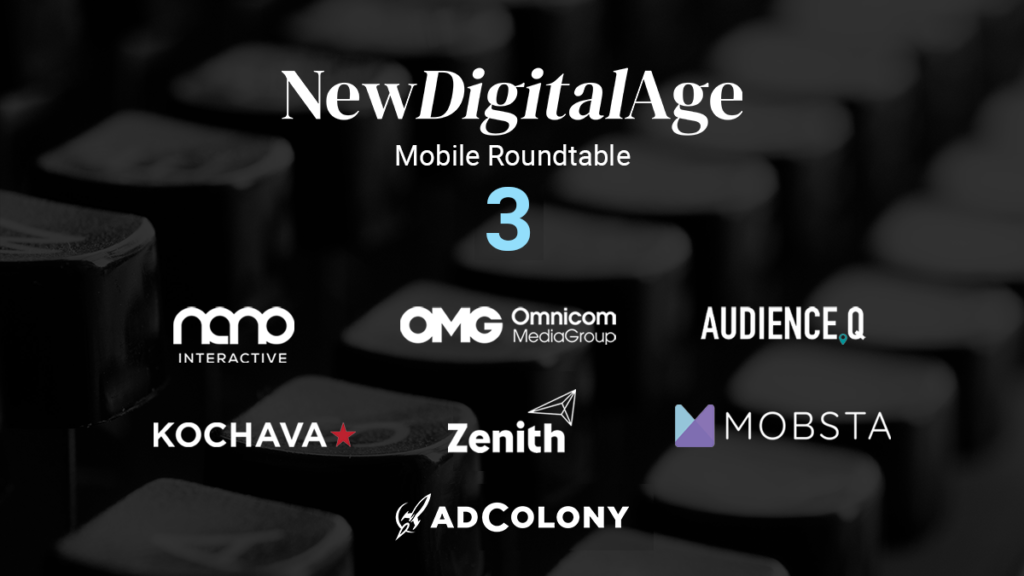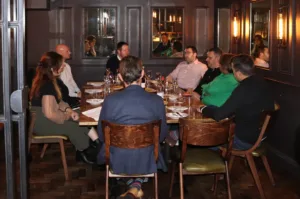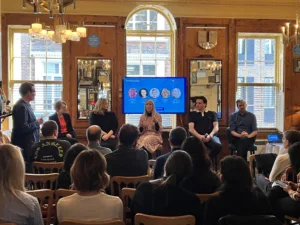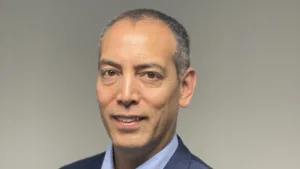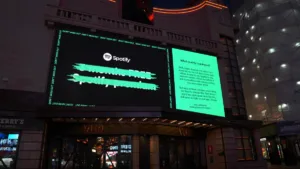It’s a so-called game-changer – 5G technology will transform tomorrow’s mobile experience in ways we cannot yet expect, the difference between it and the 4G that is prevalent today worlds apart. Or are they?
New Digital Age gathered seven mobile experts in its latest round-table event to probe the reality of mobile and advertising today and what to expect tomorrow. And the promise of 5G proved contentious.
New Digital Age Editor Justin Pearse brought together Niall Moody, Managing Director, Nano Interactive; Phil Rowley, Head of Futures at Omnicom Media Group (OMG); Ken Parnham, Co-Founder of AudienceQ; Natalie Carder, Head of Paid Social at Zenith Global; Charles Manning, CEO of Kochava; Will Dorling, UK Director of Sales at AdColony and George Dixon, Head of Product and Strategy at Mobsta to debate the changing mobile landscape.
Rowley says he has heard opposing views of the potential for 5G from technical experts, with one claiming that it will be a “massive disappointment” that has ultimately been misadvertised and another suggesting that its effects will be seismic.
He points to the messaging around how the fifth generation of mobile internet will allow users to stream 8k films on their phone, but adds that most would download commuter content from the office or home wifi and that distribution remains patchy at best. “Initially many people will not be able to avail themselves of those full services, the full potential of what the technology could possibly deliver one day.
“We may be in for a little bit of disappointment – the so-called trough of disillusionment on the Gartner hype curve.”
The opposing view, he says, is that we shouldn’t blame 5G for the fact that the companies who are advertising it are talking only about its best iteration. “The reality is, he says, that the benefit will be delivered to the majority of customers in a floor-raising exercise, not a ceiling-raising one.
For instance, less calls dropping off, far less buffering of standard YouTube streams and the ability to pick up load and demand at crowded events such as football matches or festivals. Ultimately 5G will be of benefit but it has potentially been misadvertised and people will wonder where all of the things that have been promised actually are.
Managing expectations is also key for Dorling. He says: “People don’t really know what to expect from it, and therefore we’ll just accept the improvements that come with it over time. What 5G purports to offer us in terms of, say, increased downloading speeds and functionality through faster processing will come with time, and alongside behavioural shifts.”
Even looking specifically at the gaming space, mass online games that needed extra bandwidth remain clunky, he says. “We will see gradual improvements and behaviours will shift but it’s going to take time. That you can do things a little bit quicker will be a positive but it’s not yet groundbreaking.”
He adds that the speed of ads loading is not even applicable in the app space he works in as they’re pre-cached.
The immediate benefits will be behind the scenes, suggests Dorling. An anecdote from Mobile World Congress some years ago was that the buzz of 5G was disproportionate to where 4G was at that point – it had yet to be fully rolled out. “The industry talks about this, the Facebooks of this world talk about the huge benefits without considering the cost to the networks that actually enable this technology in the first place. The perceived benefits sit in one place, whereas the cost and the hard work are on the other side of the fence.”
Yet Dixon believes the promise of 5G is “one of the most exciting subjects that we have to talk about”. Mobsta has a connection with Ericsson, a company involved in infrastructure. An expert there explained it thus: “4G is a bit like Usain Bolt, and 5G is Bolt but better – it can go in any direction, back and forth, with ease, rather than running the same 100 metre race.”
He agrees that its immediate future is in raising the floor and that the consumer promise may be some time coming, but is excited by what the technology will deliver. “It’s nerdy, but latency is key. The exciting thing, where things can communicate seamlessly, digitally, opens up a world of opportunities. Machine learning becomes more of a reality, and though self-driving cars are years away remember that it took years for 4G to gain killer apps such as Uber and Pokemon Go.”
He predicts: “I’m an optimist – I believe it’s going to be a game-changer, but just not straight away.”
Carder hopes the technology will bring innovations in ad formats. She cites the likes of Pokemon Go for building interest in more creative and immersive brand experiences. “Things such as AR and VR will definitely be seen as less of a gimmick when, with 5G, they appear very real. These are things that are growing in importance to our clients right now.”
This, particularly, following the necessary pivoting of consumer behaviour during the pandemic and subsequent lockdowns and retail restrictions. She says: “Bringing a virtual storefront to your consumer or putting a product in the consumers hands is a very useful benefit right now. That will only grow in importance as technology advances and consumers lean in. We can continue to see development of these formats and growth of investment in client terms.”
Yet for mobile to realise its potential – be it through advances in technology such as 5G or its use as a tool to drive all other channels through insights gleaned through the data it produces, mobile must break out of its box.
Says Dorling: “The biggest issue with mobile being siloed is that, you know, most people have a mobile, most people use that mobile more than any other device across the course of the day. Because it is so omnipotent in all of our lives all of the time, I find it crazy that there are conversations around ‘should we put some of our budget on mobile?’
“Well, if you’re not on mobile, then you’re arguably missing your biggest route to the consumer.”
Moody agrees that silos still exist, yet is encouraged by how the industry is evolving. “Strategy and planning teams are coming together,” he says. “And I can’t tell you the last time a client came to us with a mobile specific brief. They want to talk to audiences. We’re definitely seeing a shift towards the outcome and audience rather than device or medium. There’s a much more joined up approach.”
Manning suggests that people are thinking about audiences “a lot more thoughtfully”. “The desire for the brand and the agency to have a better ad hoc precise definition of what those audiences look like is at an all time high. They don’t necessarily want soccer moms predefined by a particular DMP, and then just start buying, and then correlating it with other audiences that are predefined, they want to think about conquesting.”
Parnham also urges the industry to change its thinking about reaching customers and how it allocates budgets. “Rather than say there is some to be spent on mobile, or OOH, think that convergence really is coming up in the next months, whenever we’re through this pandemic. There’s going to be a greater need to be able to find the right audiences – and a greater competition for them. Channel planning as it is will be null and void.”
As he concludes: “Something this panel has all agreed on is that it’s really all about the audience, it really is. The mobile is just a vehicle, it’s a point of entry.”


